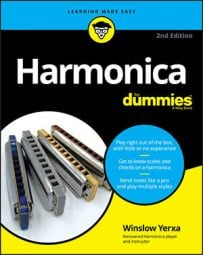Your diaphragm can help you articulate notes on the harmonica. Like your heart, your diaphragm is always working by gently propelling your lungs to inhale and exhale each breath. When you use your diaphragm to start, stop, and pulsate notes, you’re moving the entire air column so you have a huge amount of power supporting every diaphragm movement.
When you start and stop notes with an abdominal thrust, you’re articulating notes with your diaphragm. Because your diaphragm is so far away from the reed and moves all the air in your air column, diaphragm articulation has some interesting and useful characteristics:
It has almost no crispness — it’s like hitting the note with a fluffy pillow instead of with a whip.
It delivers a lot of force, but softly — it has oomph.
Diaphragm articulation doesn’t really deliver a noticeable cutoff — you stop the breath flow and the note just stops. To mark a cutoff you’d have to use your throat or tongue to end the note.
To do an abdominal thrust, you don’t have to breathe hard, and you don’t need to move your head, shoulders, or chest either. The only body part that should move is the area between your ribs and your waist, just below the apex of your rib cage. It will pull inward slightly when you exhale and bounce outward when you inhale.
To get the hang of starting an exhaled breath with an abdominal thrust, try this exercise without a harp:
Open your throat as if you’re yawning and whisper “Hah!”
Notice the little push inward that comes from the area below your rib cage. The sound of the “Hah!” will be faint because it’s produced entirely by air moving.
Try sustaining your exhaled breath for a few seconds after you give it that little push start.
It should sound something like “Haaaaaaaaaaaaa.”
Now try doing a single inhaled breath with a slight outward thrust of your abdomen — the inhaled “Hah!” with a whisper. It may feel like the sudden, involuntary intake of breath that you may make when something surprises you. The place just under the apex of your rib cage will suddenly bounce outward, and air will rush down your throat.
Finally, try starting a long inhaled breath with your diaphragm: “Haaaaaaaaaa.” Again, your throat should be open, and the only sound will be air moving.
After you try this while breathing, pick up a harmonica and try it while playing. At first you may want to try it while playing a chord of two or three notes and then while playing a single note.
Now try using your diaphragm to start and stop a series of short bursts of breath — first just by breathing, then with a harmonica. Do this while both inhaling and exhaling. Follow these steps:
Start a breath with an abdominal thrust and end it abruptly.
The breath should sound like “Hah!”
Perform a series of these short thrusts, both inhaling and exhaling.
Stop the flow of breath at the end of each “Hah!” Then resume with the next “Hah!” Your thrusts should sound like “Hah!” “Hah!” “Hah!” “Hah!” “Hah!” The series of starts and stops should be like parts in a longer breath. Each time you start again, you continue that longer breath.
Now try it with a harmonica.
Try playing a single note while doing a series of “Hah!-Hah!” abdominal thrusts, both while inhaling and while exhaling, like you just did without the harp. You can do this in any hole, but you should give Hole 4 a try.
In Chapter 6, Audio Track 0607, you can listen to the sound of diaphragm articulation on the harmonica.

